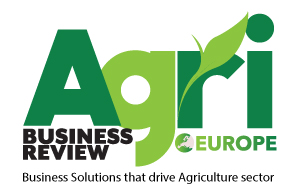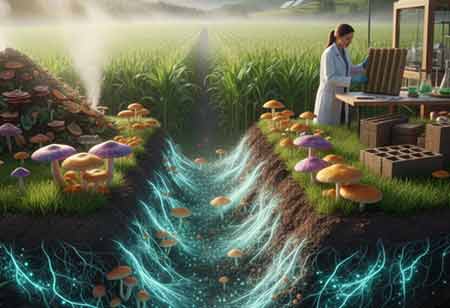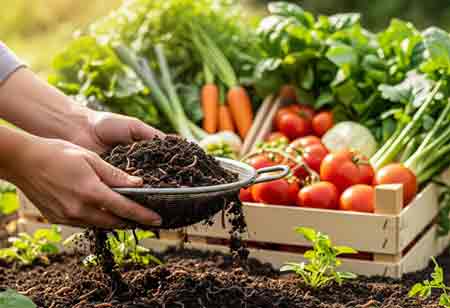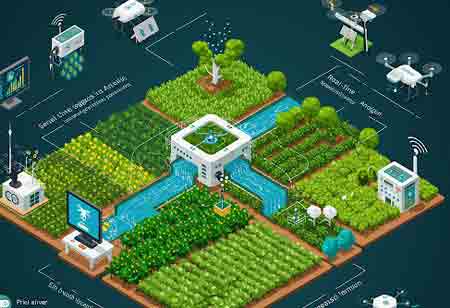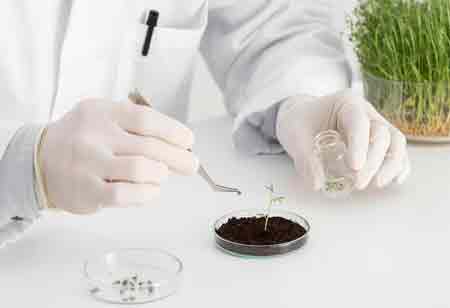Thank you for Subscribing to Agri Business Review Weekly Brief
Agri-Tech Meets Mycology: Innovations Driving Scalable Mushroom Production
Fungi cultivation is evolving into a high-tech industry, leveraging automation and data analytics to enhance efficiency, sustainability, and produce high-quality mushrooms and biomaterials.
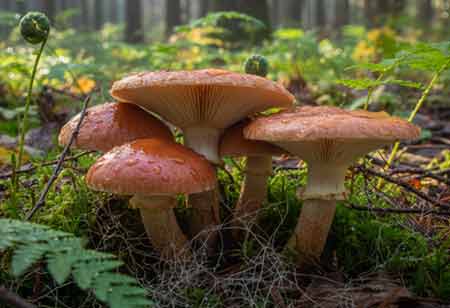
By
Agri Business Review | Friday, December 12, 2025
Stay ahead of the industry with exclusive feature stories on the top companies, expert insights and the latest news delivered straight to your inbox. Subscribe today.
The kingdom of fungi is undergoing a technological renaissance, transforming mushroom cultivation from a niche practice into a high-tech industry that drives sustainable protein, biomaterials, and nutraceuticals. This convergence of mycology and agricultural technology is unlocking unprecedented levels of scale, efficiency, and consistency, transforming mushroom farms into precision-driven bio-factories. The integration of automation, data analytics, and advanced biological techniques is not merely improving existing methods; it is fundamentally redefining what is possible in the world of mycoculture.
The journey of a mushroom begins long before the first pinhead appears. It starts with the substrate—the nutrient-rich foundation upon which mycelium, the vegetative root-like structure of the fungus, thrives. Conventionally a labor-intensive and variable process, substrate preparation is now at the forefront of technological innovation. Automated systems are being deployed to precisely mix, hydrate, and supplement bulk substrates, ensuring a homogenous and optimized nutritional profile in every batch. Following mixing, large-scale, automated sterilization and pasteurization units, governed by precise temperature and pressure controls, create a clean slate for inoculation, maximizing the potential for healthy mycelial colonization.
Inoculation itself has leaped forward from simple grain spawn transfers to the use of high-throughput liquid culture systems. These technologies enable the rapid and uniform distribution of vigorous mycelial genetics throughout the substrate, significantly reducing colonization times and enhancing the biological efficiency of the entire growth cycle. Throughout this crucial phase, embedded sensors are becoming instrumental. By monitoring key metrics such as internal substrate temperature, moisture content, and carbon dioxide (CO₂) levels in real-time, cultivators gain an unparalleled view into the metabolic activity of the mycelium. This data allows for micro-adjustments that support vigorous, uncontested growth, laying the perfect groundwork for a prolific harvest.
The Smart Environment: AI-Powered Climate Control
Once the mycelium has fully colonized its substrate, the focus shifts to initiating the fruiting phase—a delicate process that hinges on precise environmental cues. Here, the principles of Controlled Environment Agriculture (CEA) are being applied with remarkable success. Modern mushroom cultivation facilities are increasingly equipped with sophisticated climate control systems that govern every atmospheric variable.
A network of Internet of Things (IoT) sensors continuously streams data on ambient temperature, relative humidity, and CO₂ concentration, and Fresh Air Exchange (FAE) rates to a central control unit. This is where artificial intelligence and machine learning algorithms are making a significant impact. Instead of relying on static setpoints, these intelligent systems can learn the optimal environmental recipes for specific mushroom species and even specific genetic strains. The AI can adjust conditions, for example, by increasing humidity through ultrasonic misters during early pinning and then ramping up air exchange to encourage robust fruit body development. This responsive, data-driven approach not only optimizes growth but also ensures a level of consistency and quality that is difficult to achieve with manual oversight, leading to uniform, predictable, and high-yielding harvests cycle after cycle.
Data-Driven Cultivation: The Rise of the Algorithmic Mycologist
The true power of modern agri-tech in mycology lies in its ability to harness vast amounts of data. The modern mushroom farm is a data-rich environment, and sophisticated farm management platforms are emerging to centralize and interpret this information. These dashboards provide cultivators with a holistic view of their entire operation, from substrate batch performance to the environmental history of each grow room.
This data is the fuel for powerful predictive analytics. By analyzing historical trends, machine learning models can forecast yields with increasing accuracy, thereby enabling more effective inventory management and supply chain planning. Furthermore, computer vision systems are being integrated into this data ecosystem. High-resolution cameras continuously monitor the crop, with AI models trained to recognize different growth stages, assess canopy density, and identify uniformity across the growing beds. This visual data provides another layer of insight, allowing for automated quality control and the precise timing of interventions, such as adjusting light schedules or initiating the harvest sequence. For the broader supply chain, blockchain technology offers a pathway to create immutable records of a product's journey, providing ultimate transparency from inoculation to the end consumer.
The Automated Harvest: Robotics and Intelligent Post-Processing
Robotic systems equipped with advanced computer vision and soft-touch grippers are being developed to identify and selectively pick mushrooms that have reached peak maturity. These systems can operate consistently and gently, preserving the quality of the final product around the clock.
Once harvested, automation continues to streamline the post-harvest workflow. Automated sorting systems utilize optical sensors to grade mushrooms based on size, shape, and color, directing them to different processing or packaging lines. This not only increases throughput but also ensures that products consistently meet market specifications. Advanced packaging and preservation technologies, such as modified atmosphere packaging, are further extending the shelf life and market reach of fresh mushrooms, while sophisticated drying and extraction techniques are creating a new generation of high-value powders, tinctures, and functional food ingredients.
The synthesis of technology and mycology is setting the stage for a future where mushroom cultivation plays a central role in a sustainable, circular bioeconomy. The next generation of facilities will likely be fully autonomous vertical farms, capable of operating in urban centers and producing vast quantities of food and biomaterials with a minimal environmental footprint. The inherent ability of fungi to upcycle agricultural and industrial byproducts as substrate positions mycoculture as a key solution for waste valorization. The fusion of data science, robotics, and biology is forging a new paradigm, transforming the humble mushroom into a cornerstone of 21st-century innovation.
